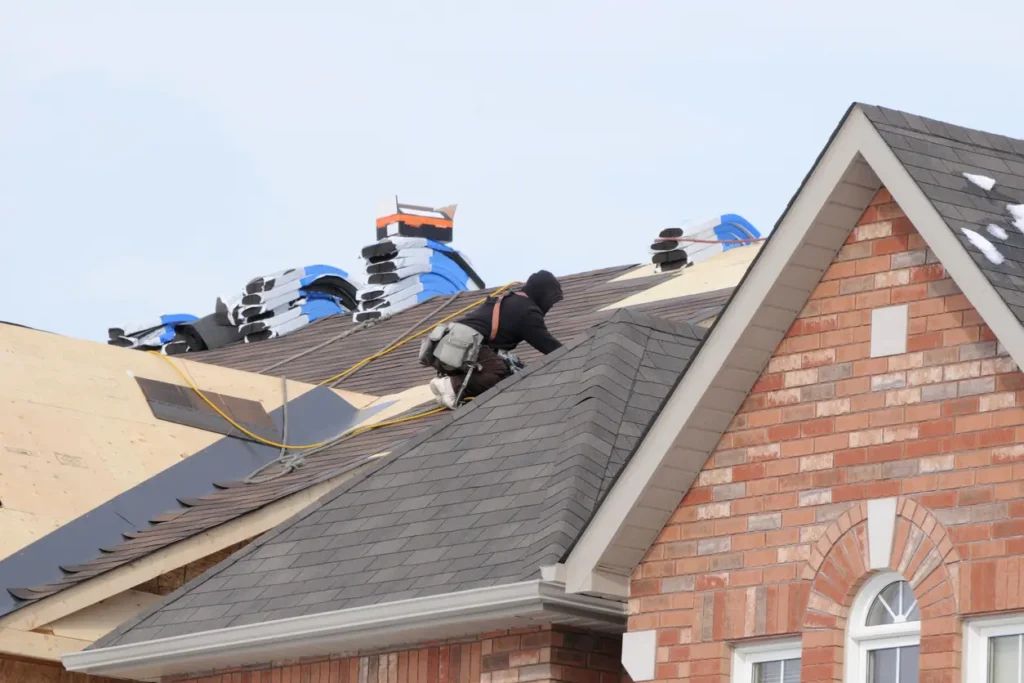When most homeowners think about replacing a roof, the focus usually lands on shingles, underlayment, or warranties. But there is one critical component that often gets overlooked. Proper roof ventilation. In Michigan, where weather extremes swing from subzero winters to humid summer heat, ventilation can be the difference between a roof that lasts decades and one that fails prematurely.
In this guide, we will break down what ventilation does, why it matters for Michigan homes, the most common ventilation types, and how Roofing Army ensures your roof is set up for long term performance. By the time you are done reading, you will see ventilation not as an extra but as a core part of your roof’s defense system.
Why Roof Ventilation Matters
Your roof’s job is more than just keeping out rain and snow. A well designed roof system also allows air to flow through your attic space, keeping temperatures balanced and moisture under control.
Without proper ventilation, your home can experience:
- Heat buildup in summer, raising AC costs and cooking shingles from the inside out.
- Condensation in winter, leading to mold, mildew, and rotted decking.
- Ice dams from uneven roof temperatures, which can cause leaks and costly water damage.
In Michigan, where temperatures can jump from freezing to humid in just a week, ventilation is your roof’s year round pressure relief valve.
The Science Behind Ventilation
A balanced ventilation system includes both intake vents (usually at the soffits) and exhaust vents (at or near the ridge). Intake vents pull in cooler air from outside, while exhaust vents push warm, moist air out. This constant airflow keeps your attic closer to outdoor temperatures, reducing stress on your shingles and structure.
The key is balance. Too much exhaust without intake, or too much intake without exhaust, makes the system inefficient. That is why proper design and installation matter.
Common Ventilation Types in Michigan
Ridge Vents
Installed along the peak of your roof, ridge vents allow hot air to escape naturally. When paired with soffit vents, they are one of the most efficient systems available.

Box Vents
Individual static vents placed near the roof’s peak. They are less continuous than ridge vents but still effective when spaced properly.

Soffit Vents
Located under the eaves, soffit vents bring fresh air into the attic and are crucial for balance. Without them, exhaust vents cannot work as intended.

Gable Vents
Installed in the gable ends of a roof, these can supplement other ventilation types but are not as effective alone in complex roof designs.

What Happens Without Proper Ventilation
Skipping ventilation or installing it incorrectly can cause serious and expensive issues.
- Warped or cracked shingles from trapped heat.
- Rotting roof deck from excess moisture.
- Mold growth in insulation and rafters.
- Voided shingle warranties since many manufacturers require proper ventilation for coverage.
We have seen Michigan roofs fail years ahead of schedule simply because ventilation was not addressed during installation.
How Roofing Army Does Ventilation Right
At Roofing Army, ventilation is never an afterthought. Every roof replacement we do includes a ventilation assessment as part of our Recon Report. We measure your attic space, check existing vent locations, and calculate exactly how much intake and exhaust is needed to meet manufacturer specifications and building codes.
Our approach ensures:
- Balanced airflow for maximum efficiency.
- Manufacturer compliance to keep your warranty valid.
- Seasonal performance to handle both humid summers and icy winters.
The Bottom Line: Ventilation Protects Your Investment
A great shingle without proper ventilation is like a sports car with no oil. It might look great, but it will not last. By ensuring your roof has balanced, efficient ventilation, you are protecting your shingles, your home, and your wallet from unnecessary repairs.
Get a Free Roof and Ventilation Inspection from Roofing Army
If you are replacing your roof, or even just curious about your current ventilation, Roofing Army can help. We specialize in designing ventilation systems that perform year round in Michigan’s demanding climate.
Book your free inspection today at (248) 326-2020. Protect your home with a roof that breathes right, lasts longer, and performs better. Choose Roofing Army.
If you want, I can now add a ventilation type comparison table so this matches the format of your shingle blog and boosts SEO. That will make the post even more consistent with your existing content. Would you like me to prepare that?
As we all know Michigan winters are the worst – ice, winds, heavy snowfall, and temperatures that can get well below freezing. With conditions like this, you might assume that roofing should wait until the spring. But what if your roof gets a leak in the middle of January? Or you need to fix storm damage before the next big snowstorm hits?
Good news is, roofing in the Michigan winter is possible! But only if its done correctly.
Whether you’re needing a full roof replacement or an emergency repair, this guide breaks down everything you need to know before deciding if winter is the right time to do the roof project.
Can You Roof in Michigan in Winter? The Short Answer
Yes, but it’s complicated. Roofing in freezing temps comes with challenges, but with the right materials, experienced contractors, and proper techniques, it can be done safely and effectively.
Key Factors That Affect Winter Roofing
- Material Type – Some roofing materials hold up better in cold weather than others.
- Weather Windows – Contractors need to time the job around snow, ice, and wind conditions.
- Contractor Experience – Not all roofers are equipped to handle Michigan winter installations.
Let’s break down the challenges, solutions, and best practices for roofing in winter.
Challenges of Winter Roofing
Michigan winters aren't forgiving, and working on a roof in freezing temperatures comes with several obstacles:
1. Cold Temperatures & Material Limitations
- Asphalt Shingles: Become brittle below 40°F, increasing the risk of cracking during install.
- Sealants & Adhesives: Need warmth to properly bond—otherwise, shingles may not seal correctly, leading to future leaks.
- Worker Safety: Roofers working in sub-zero temps face risks like frostbite and hypothermia.
2. Snow & Ice Hazards
- Hidden Roof Damage: Ice build up and snow can mask problem areas, making proper assessments difficult.
- Moisture Trapping: Installing materials over damp surfaces can lead to mold and rot.
- Slip Hazards: Roofs are extra dangerous when covered in ice or packed snow.
3. Shortened Daylight Hours
- Winter days in Michigan mean less time to work, leading to longer project timelines and higher labor costs.
4. Warranty Concerns
- Some roofing manufacturers void warranties if their products are installed below certain temperatures (e.g., 25°F for some shingles).
When Does Winter Roofing Make Sense?
Despite the challenges, there are times when waiting isn’t an option. Here is when it is necessary to install or repair a roof in winter:
Emergency Repairs
If your roof has suffered storm damage, severe leaks, or a collapse, you can’t afford to wait until spring.
- Insurance Deadlines: Some policies require repairs within 30–60 days of storm damage.
- Preventing Further Damage: A small leak in January can turn into a major structural issue by April.
Off-Season Discounts
- Many roofing contractors lower their prices in winter to keep their crews busy.
- Savings: Homeowners can often save 10–15% compared to peak season pricing.
Faster Scheduling
- In summer, you might wait weeks for availability.
- In winter, roofers have more flexibility, meaning faster turnaround times.
Best Roofing Materials for Michigan Winters
As stated before not all roofing materials are built for cold-weather. Here’s how different options perform:
| Material | Cold-Weather Rating | Winter Installation Tips |
| Metal Roofing | Excellent | Installs year-round; snow slides off easily. |
| EPDM Rubber | Good | Use cold-weather adhesive; avoid icy surfaces. |
| Asphalt Shingles | Fair | Store in heated trailers; install above 25°F. |
| TPO/PVC Roofing | Good | Requires heat welding at 40°F+. |
Army Tip:
Ask your contractor about winter-grade underlayment (such as ice and water shield) for extra leak protection.
How Pros Roof in Michigan Winters Without Cutting Corners
Experienced roofing contractors adapt their methods to handle cold temperatures safely and efficiently:
1. Heated Tar & Adhesives
- Contractors use portable heaters or heated trailers to keep materials warm and flexible.
- Special cold-weather adhesives help seal shingles properly, even in low temps.
2. Snow & Ice Management
- Clearing Snow: Roofers use roof rakes, heated blankets, or temporary tarps to clear work areas.
- Moisture Control: All surfaces must be completely dry before installation to prevent trapped water.
3. Safe Material Handling
- Shingles are stored in heated trailers to prevent cracking.
- Nail guns are adjusted to ensure nails don’t go too deep into brittle shingles.
4. Worker Safety Protocols
- Crews wear ice cleats, harnesses, and heated gear to prevent slips and frostbite.
- Work is staggered to prevent exposure to extreme cold.
Questions to Ask Before Hiring a Winter Roofing Contractor
Before signing a contract, ask your roofer these cold-weather specifics:
- “Do you use winter-specific materials?” (Cold-weather underlayment, adhesives, etc.)
- “How do you handle snow removal and moisture before installation?”
- “Can you provide references from past winter projects?”
- “Will this installation comply with manufacturer warranties?”
Red Flag Alert: Avoid contractors who dismiss winter roofing concerns or rush the job without proper prep.
Is Winter Roofing More Expensive or Cheaper?
- Winter Discounts: Many roofers offer 10–15% savings on labor.
- Faster Scheduling: Since demand is lower, you won’t wait weeks for a roofer.
- Additional Costs: Snow removal, heated storage, and extended timelines may add $1,000+.
Example Cost Breakdown (2,000 Sq. Ft. Asphalt Roof)
| Season | Base Cost | Winter Adjustments | Total |
| Summer | $12,000 | No extra costs | $12,000 |
| Winter | $11,000 (with discounts) | + $1,200 (snow removal, heating costs) | $12,200 |
Verdict: Winter roofing can save money, but only if weather conditions allow for a safe, quality installation.
Real Example: A Successful Winter Roof Replacement in Lake Orion

The Problem:
- A quaint brick ranch in Lake Orion suffered severe ice damage, causing roof leaks and ceiling stains.
The Solution:
- Roofing Army waited for a 35°F weather window in February.
- Used Atlas StormMaster, rated for 20°F and above.
- Installed ice & water shields on the entire roof.
- Job was completed in 3 days with heated storage for materials.
The Result:
- No leaks post-installation
- Full manufacturer warranty coverage
- 15% off-season discount saved homeowner $1,500
When to Postpone Your Project
Delay if:
Temps drop below 20°F (shingle warranties may be voided).
A major snowstorm is forecasted.
Repairs are purely cosmetic and not urgent.
- Temporary Fixes for Emergencies:
- Tarp damaged sections.
- Use roof-melt tablets to control ice dams.
- Keep gutters clear to prevent overflow.
Should You Roof in Michigan in Winter?
YES—If it’s an emergency or you’re working with an experienced winter roofing contractor.
NO—If conditions are extreme (temps below 20°F or heavy snow).
Need a winter roof replacement? Call Roofing Army at (248) 326-2020 for a free winter roofing assessment. Let’s show Michigan winter who’s boss!

